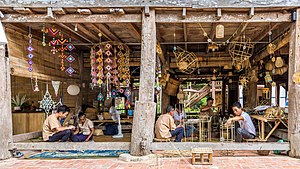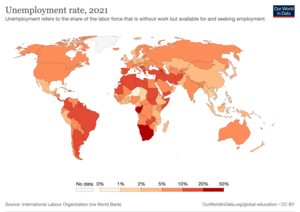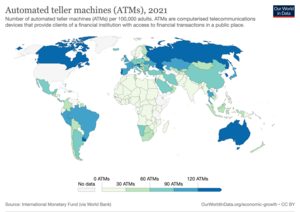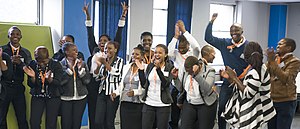Sustainable Development Goal 8: Difference between revisions
links, content and citation |
links, content and citation |
||
| Line 213: | Line 213: | ||
* [[Fonkoze]] is [[Haiti|Haiti’s]] largest [[microfinance]] institution empowering [[Haitians]], primarily women, with financial and development services to lift their families out of [[poverty]].<ref>{{Cite web|title=Breaking the Cycle of Poverty Across Haiti- FONKOZE|url=https://fonkoze.org/|access-date=2020-09-24|website=fonkoze.org|language=en-US}}</ref> it offers a full range of financial and development services to Haiti’s rural poor and provides them with the required tools and training to live a good life.<ref name=":6" /> |
* [[Fonkoze]] is [[Haiti|Haiti’s]] largest [[microfinance]] institution empowering [[Haitians]], primarily women, with financial and development services to lift their families out of [[poverty]].<ref>{{Cite web|title=Breaking the Cycle of Poverty Across Haiti- FONKOZE|url=https://fonkoze.org/|access-date=2020-09-24|website=fonkoze.org|language=en-US}}</ref> it offers a full range of financial and development services to Haiti’s rural poor and provides them with the required tools and training to live a good life.<ref name=":6" /> |
||
* P+SITIVE PLANET aims to develop and create positive economy in every line of business.<ref>{{Cite web|title=Positive Planet - Create a better world for future generations|url=https://positiveplanet.ngo/en/|access-date=2020-09-24|website=Positive Planet|language=en-US}}</ref> Promoting positive economies through micro-finance strategies, and it offers both financial and non-financial services, improving the lives of hundreds of millions of people.<ref name=":6" /> |
* P+SITIVE PLANET aims to develop and create positive economy in every line of business.<ref>{{Cite web|title=Positive Planet - Create a better world for future generations|url=https://positiveplanet.ngo/en/|access-date=2020-09-24|website=Positive Planet|language=en-US}}</ref> Promoting positive economies through micro-finance strategies, and it offers both financial and non-financial services, improving the lives of hundreds of millions of people.<ref name=":6" /> |
||
* [[Root Capital]] is a nonprofit social investment fund that invests in the growth of agricultural enterprises.<ref>{{Cite web|title=Homepage|url=https://rootcapital.org/|access-date=2020-09-24|website=Root Capital}}</ref> It sees to the growth of rural prosperity in poor, and environmentally vulnerable places in [[Africa]] and [[Latin America]] by lending capital and delivering financial training to farmer associations and various private businesses to aid their development and transforms rural communities. <ref name=":6" /> |
|||
Revision as of 13:36, 24 September 2020
| Sustainable Development Goal 8 | |
|---|---|
 | |
| Mission statement | "Promote sustained, inclusive and sustainable economic growth, full and productive employment and decent work for all" |
| Commercial? | No |
| Type of project | Non-Profit |
| Location | Global |
| Owner | Supported by United Nation & Owned by community |
| Founder | United Nations |
| Established | 2015 |
| Disestablished | 2030 |
| Website | sdgs |
Sustainable Development Goal 8 (SDG 8 or Goal 8) is about "decent work and economic growth" and is one of the 17 Sustainable Development Goals which were established by the United Nations General Assembly in 2015. The full title is to: "Foster sustained, inclusive and sustainable economic growth, full and productive employment and decent work for all."[1][2] SDG 8 aims at fostering sustainable and equitable economic growth for all workers, irrespective of their background, race or gender.[3] This means achieving “higher levels of economic productivity through diversification, technological upgrading and innovation, including through a focus on high-value added and labour-intensive sectors.”[3]
The Goal has 12 targets to be achieved by 2030. Progress towards targets will be measured, monitored and evaluated by 17 indicators. One of the targets is: "By 2030, the target is to establish policies for sustainable tourism that will create jobs". This means that every country will be able to generate income as it aims at improving its tourist attraction.[4]
This goal aims at ensuring the economic sector of every country provides the necessary need for its citizen to have a good life irrespective of their background, race or culture.[5] Roughly half the world's population still lives on the equivalent of about US$2 a day. Besides, in too many places, having a job does not guarantee the ability to escape from poverty. This slow and uneven progress requires everyone to rethink and retool the economic and social policies aimed at eradicating poverty.[6]
Background
For close to three decades, the number of workers living in extreme poverty has reduced drastically. This is despite the lasting impact of the 2008 economic crisis and global recession. In developing countries, 34 per cent of total employment were for the middle class, a number that has increased rapidly between 1991 and 2015.[6]

In spite of that, the global economy continues to recover; the world is seeing slower growth, inequalities widened, and low level of job opportunity that is not commensurate of the labour force.
Prior to the outbreak of Covid-19 pandemic, the global economy was growing at a slower rate than in previous years notwithstanding improvements in labour productivity and unemployment.[7] The pandemic has quickly and greatly disrupted it, pushing the world into a recession.[7] The extraordinary shock to the world's labour markets is expected to result in a decrease of around 10.5 per cent in aggregate working hours in the second quarter of 2020, equivalent to 305 million full-time workers.[7] Small and medium enterprises, workers in informal employment, the self-employed, daily wage earners and workers in sectors at the highest risk of disruption have been hit the hardest.[7]
Employment growth since 2008 has averaged only 0.1% annually, compared with 0.9% between 2000 and 2007. Over 60 per cent of all workers does not have an employment contract.[8][9]
Targets, indicators and progress
The UN has defined 12 Targets and 17 Indicators for SDG 8. The 12 Targets specify the goals and indicators represent the metrics by which the world aims to track whether these targets are achieved by using the years stated and documented for the indicators actualisation; two of the indicators are to be achieved by the by year 2020, one by the year 2025, and the remaining fourteen indicators are to be achieved by 2030, which sum it up to seventeen.[10] Each of the 17 Indicator is used to measure the progress and the success of the decent work and global economic growth for all.[10]
Target 8.1: Sustainable economic growth

The full title of Target 8.1 is: "Sustain per capita economic growth in accordance with national circumstances and, in particular, at least 7 per cent gross domestic product growth per annum in the least developed countries".[2]
It has one indicator:
- Indicator 8.1.1: Annual growth rate of real GDP per capita [4]
In 2018, the rate of growth of global real GDP per capita was 2 per cent. In addition, the rate for least developed countries was 4.5 per cent in 2018, less than the 7 per cent growth rate targeted in SDG 8. The Covid-19 pandemic is pushing the world into the worst global economic crisis since the Great Depression.[11]
The custodian agency for this target are the United Nations Department of Economic and Social Affairs (UN-DESA) and United Nations Statistics Division (UNSD). The two agencies are in charge of the data gathering for the progress of Indicator 8.1.1.[12]
Target 8.2: Diversify, innovate and upgrade for economic productivity

The official wording for Target 8.2 is: "Achieve higher levels of economic productivity through diversification, technological upgrading and innovation, including through a focus on high-value added and labour-intensive sectors."[2]
It has one indicator:
After a brief interruption during the global economic downturn of 2008–2009, labour productivity has continued to grow; in 2019, it increased by 1.4 per cent from the previous year.[7]
The custodian agency for this target is International Labour Organisation(ILO) which is in charge of the data gathering for the progress of Indicator 8.2.1.[12]
Target 8.3: Promote policies to support job creation and growing enterprises

The official wording for Target 8.3 is: "Promote development-oriented policies that support productive activities, decent job creation, entrepreneurship, creativity and innovation."[2]
It has one indicator:
- Indicator 8.3.1: Proportion of informal employment in non-agriculture employment, by sex [4]
The custodian agency for this target is International Labour Organisation (ILO). This agency is in charge of the data gathering for the progress of Indicator 8.3.1.[12]
Target 8.4: Improve resource efficiency in consumption and production


The official title of Target 8.4 is: "Improve progressively, through 2030, global resource efficiency in consumption and production and endeavour to decouple economic growth from environmental degradation, in accordance with the 10‑Year Framework of Programs on Sustainable Consumption and Production, with developed countries taking the lead."[2]
It has two indicators:
- Indicator 8.4.1: Material footprint, material footprint per capita, and material footprint per GDP
- Indicator 8.4.2: Domestic material consumption, domestic material consumption per capita, and domestic material consumption per GDP
The total material footprint is the sum of the material footprint for biomass, fossil fuels, metal ores and non-metal ores. Data on material footprints are outdated and unavailable after the year 2010.[4]
The custodian agency for the two indicators under "Target 8.4" is United Nations Environment Programme (UNEP).[16]
Target 8.5: Full employment and decent work with equal pay
The full title for Target 8.5 is: "By 2030, achieve full and productive employment and decent work for all women and men, including for young people and persons with disabilities, and equal pay for work of equal value".[2]

Target 8.5 has two indicators:[4]
- Indicator 8.5.1: Average hourly earnings of female and male employees, by occupation, age and persons with disabilities
- Indicator 8.5.2: Unemployment rate, by sex, age and persons with disabilities
Average earnings are reported for male and female employees, but not available across countries for further breakdowns.[4] Data on average hourly earnings cast light on income inequality.[7] In 2017, a factor-weighted gender pay gap of 19 per cent was determined.[7] The unemployment rate is available for the total population, in addition to breakdown by sex.[4]
600 million new jobs need to be created by 2030, just to keep pace with the growth of the working age population.[17] More than 204 million people were unemployed in 2015.[18]
Fewer than 45 per cent of wage and salaried workers are employed on a full-time, permanent basis, and even that share is declining. Again, 204 million people are unemployed in 2015. By 2019, more than 212 million people will be out of work, up from the current 201 million.[19]
The custodian agency for the two indicators under Target 8.5 is International Labour Organisation (ILO) which is in charge of the data gathering for the progress of these indicators.[12]
Target 8.6: Promote youth employment, education and training

The full title for Target 8.6 is: "By 2020, substantially reduce the proportion of youth not in employment, education or training".[2] Unlike most SDG targets set for the year 2030, this is set to be achieved by 2020.[4]
- Indicator 8.6.1: Proportion of youth (aged 15–24 years) not in education, employment or training
In 2019, 22 per cent of the world's young people were not in employment, education or training, a figure that has hardly changed since 2005.[7] Addressing youth employment means finding solutions with and for young people who are seeking a decent and productive job. Such solutions should address both supply, i.e. education, skills development and training, and demand.[21]
The custodian agency for "Target 8.5" is International Labour Organisation (ILO) which is in charge of the data gathering for the progress of the indicator under this target.[12]

Target 8.7: End modern slavery, trafficking, and child labour
The full title for Target 8.7 is "Take immediate and effective measures to eradicate forced labour, end modern slavery and human trafficking and secure the prohibition and elimination of the worst forms of child labour, including recruitment and use of child soldiers, and by 2025 end child labour in all its forms".[2]
There is one indicator:
- Indicator 8.7.1: Proportion and number of children aged 5–17 years engaged in child labour, by sex and age [4]
The custodian agencies for the only indicator under Target 8.7 are: International Labour Organisation (ILO) and United Nations International Children's Emergency Fund (UNICEF) which are in charge of the data gathering for the progress of the indicator.[12]
Target 8.8: Protect labour rights and promote safe working environments

The full title of the Target 8.8 is: "Protect labour rights and promote safe and secure working environments for all workers, including migrant workers, in particular women migrants, and those in precarious employment".[2]
It has two indicators:[4]
- Indicator 8.8.1: Frequency rates of fatal and non-fatal occupational injuries, by sex and migrant status
- Indicator 8.8.2: Level of national compliance with labour rights (freedom of association and collective bargaining) based on International Labour Organization (ILO) textual sources and national legislation, by sex and migrant status
Substandard working conditions are often related to poverty, inequality and discrimination. In many contexts, certain groups – such as workers with disabilities, women workers, youth, and migrants, among others – face particular obstacles in accessing decent work and may be especially vulnerable to abuses.[10]
The custodian agency for the two indicators for "Target 8.8." is International Labour Organisation (ILO). ILO ensure labor right with working environment.[16]

Target 8.9: Promote beneficial and sustainable tourism
The full text for Target 8.9 is "By 2030, devise and implement policies to promote sustainable tourism that creates jobs and promotes local culture and products."[2]
It has to indicators:[4]
- Indicator 8.9.1: Tourism direct GDP as a proportion of total GDP and in growth rate
- Indicator 8.9.2: The proportion of jobs in sustainable tourism industries out of total tourism jobs
A proposal has been tabled in 2020 to delete Indicator 8.9.2.[23]
The custodian agency for the indicators under "Target 8.9" is United Nations World Tourism Organization (UNWTO). This agency is in charge of the data gathering for the progress of Indicator 8.3.1.[12]

Target 8.10: Universal access to banking, insurance and financial services

The official text for Target 8.10 is: "Strengthen the capacity of domestic financial institutions to encourage and expand access to banking, insurance and financial services for all".[2]
Target 8.10 has two indicators:[4]
- Indicator 8.10.1: Number of commercial bank branches per 100,000 adults and (b) number of automated teller machines (ATMs) per 100,000 adults
- Indicator 8.10.2: Proportion of adults (15 years and older) with an account at a bank or other financial institution or with a mobile-money-service provider

The outbreak of the Covid-19 pandemic in 2020 has reduced the growth of every economy in the world, including every sector like banking, insurance and services.[7]
The custodian agency for the Indicator 8.10.1 is International Monetary Fund,[12] while the custodian agency for Indicator 8.10.2 is: World Bank (WB).[12]
Target 8.a: Increase aid for trade support
The official wording for Target 8.a "Increase Aid for Trade support for developing countries, in particular least developed countries, including through the Enhanced Integrated Framework for Trade-related Technical Assistance to Least Developed Countries."[2]
- Indicator 8.a.1: Aid for trade commitments and disbursements
The indicator 8.a.1 is measured as total Official Development Assistance (ODA) allocated to aid for trade in 2015 US$.
In 2018, aid for trade commitments remained stable, at $58 billion, based on current prices.[7] South and Central Asia received the highest share thereof (31.4 per cent), followed by sub-Saharan Africa (29.2 per cent).[7] Lower-middle-income countries received 37.5 per cent of aid for trade, followed by least developed countries (36.8 per cent).[7]
The custodian agency for the "Indicator 8.a" is Organisation for Economic Co-operation and Development (OECD)[12]
Target 8.b: Develop a global youth employment strategy

The full title of Target 8.b is: "By 2020, develop and operationalize a global strategy for youth employment and implement the Global Jobs Pact of the International Labour Organization".[2]
It has one indicator:
- Indicator 8.b.1: Existence of a developed and operationalized national strategy for youth employment
Unlike most SDG targets with a target for 2030, the goal date for this indicator is 2020.
According to data for 2019, 98 per cent of the countries surveyed had a youth employment strategy or a plan to develop one in the near future.[7]
The custodian agency for this "Target 8.b.1" is International Labour Organisation (ILO). ILO as the agency for this indicator is in charge of the data gathering for the progress of Global Youth Empowerment Strategy.[12]
Monitoring
High-level progress reports for all the SDGs are published in the form of reports by the United Nations Secretary General, the most recent one is from April 2020.[11]
Society and culture
Businesses are engines for job creation and economic growth and foster economic activity through their value chain. Decent work opportunities are good for business and society. Companies that uphold labor standards across their own operations and value chains face lower risk of reputational damage and legal liability. Instituting non-discriminatory practices and embracing diversity and inclusion will also lead to greater access to skilled, productive talent.[25]
Links with other SDGs
The attainment of SDG 8 is vested on the success and progress of other SDGs. There can not be growth in the economy of any country if its citizens are not well educated. Therefore, SDG 8; Decent Work and Economic Growth interlinks with quality education (SDG 4)[26], gender equality (SDG 5) for equal work opportunities.[27] There are also strong ties with Industry, innovation and infrastructure (SDG 9)[28] and responsible consumption and production (SDG 12).[29] Aside for the aforementioned inter-related SDGs, it s worthy to note that the progress of SDG 8 aids to reduce the per cent poverty rate in any given country on Poverty ranks. SDG 8 is related to no poverty (SDG 1)
Organizations
- World Bank Group: Since the inception of the Global Goals, The World Bank has been in support with the vision to alleviate poverty and empower both gender through its training, resources mobilisation and others.[30][31]
- United Nations Office for Outer Space Affairs (UNOOSA)
- International Labour Organisation[8]
- UN Women acts to "achieve economic rights and growth for all by promoting decent work, equal pay for equal work, equal access to economic assets and opportunities, and the fair distribution of unpaid care work".[32]
- United Nations World Tourism Organization (UNWTO)
NGOs and others
The following NGOs and other organizations are helping to achieve SDG 8:
- KIVA is a loan platform that help improve the living conditions of people through lending with access to traditional forms of finance, credit, and banking. [33]
- Fonkoze is Haiti’s largest microfinance institution empowering Haitians, primarily women, with financial and development services to lift their families out of poverty.[34] it offers a full range of financial and development services to Haiti’s rural poor and provides them with the required tools and training to live a good life.[33]
- P+SITIVE PLANET aims to develop and create positive economy in every line of business.[35] Promoting positive economies through micro-finance strategies, and it offers both financial and non-financial services, improving the lives of hundreds of millions of people.[33]
- Root Capital is a nonprofit social investment fund that invests in the growth of agricultural enterprises.[36] It sees to the growth of rural prosperity in poor, and environmentally vulnerable places in Africa and Latin America by lending capital and delivering financial training to farmer associations and various private businesses to aid their development and transforms rural communities. [33]
Reception
World Pensions Council (WPC) development economists have argued that the twin considerations of long-term economic growth and infrastructure investment were not prioritized enough. The fact they were designated as the number 8 and number 9 objective respectively was considered a rather "mediocre ranking [which] defies common sense".[37]
Continued global economic growth of 3 percent (Goal 8) may not be reconcilable with ecological sustainability goals, because the required rate of absolute global eco-economic decoupling is far higher than any country has achieved in the past.[38]
References
- ^ United Nations (2015) Resolution adopted by the General Assembly on 25 September 2015, Transforming our world: the 2030 Agenda for Sustainable Development (A/RES/70/1)
- ^ a b c d e f g h i j k l m United Nations (2017) Resolution adopted by the General Assembly on 6 July 2017, Work of the Statistical Commission pertaining to the 2030 Agenda for Sustainable Development (A/RES/71/313)
- ^ a b "17 Companies Helping Meet the 17 UN Sustainable Development Goals". The Founder Institute. Retrieved 2020-09-03.
- ^ a b c d e f g h i j k l m n o p q r Ritchie, Roser, Mispy, Ortiz-Ospina (2018) "Measuring progress towards the Sustainable Development Goals." (SDG 8) SDG-Tracker.org, website
- ^ "Sustainable Development Goal 8". SDGs UN Organisation. Retrieved September 19, 2020.
{{cite web}}: CS1 maint: url-status (link) - ^ a b "Goal 8: Decent work and economic growth". UNDP. Retrieved 2020-09-01.
- ^ a b c d e f g h i j k l m "United Nations Economic and Social Council - E/2020/57 Progress towards the Sustainable Development Goals, Report of the Secretary-General". undocs.org. Retrieved 2020-09-02.
{{cite web}}: CS1 maint: url-status (link) - ^ a b "Goal #8: Decent work and economic growth (The 2030 development agenda)". www.ilo.org. Retrieved 2020-09-01.
- ^ "Goal 8 Pdf Upload on SDG Compass" (PDF).
{{cite web}}: CS1 maint: url-status (link) - ^ a b c "SDG Compass Goal 8".
{{cite web}}: CS1 maint: url-status (link) - ^ a b United Nations Economic and Social Council (2020) Progress towards the Sustainable Development Goals Report of the Secretary-General, High-level political forum on sustainable development, convened under the auspices of the Economic and Social Council (E/2020/57), 28 April 2020
- ^ a b c d e f g h i j k "United Nations (2018) Economic and Social Council, Conference of European Statisticians, Geneva," (PDF). United Nations, Geneva. Retrieved September 19, 2020.
{{cite web}}: CS1 maint: url-status (link) - ^ Promote inclusive and sustainable economic growth, employment and decent work for all, (SDG 8) SDG-Tracker.org, website
- ^ SDG-Tracker.org, website
- ^ SDG-Tracker.org, website
- ^ a b "United Nations (2018) Economic and Social Council, Conference of European Statisticians, Geneva," (PDF). United Nations, Geneva. Retrieved September 19, 2020.
{{cite web}}: CS1 maint: url-status (link) - ^ "Jobs at the Core of Development: Transforming Economies and Societies through Sustainable Employment". World Bank. Retrieved 2020-09-01.
- ^ "United Nations Development Programme Official Websie".
{{cite web}}: CS1 maint: url-status (link) - ^ "International Labour Organization". www.ilo.org. Retrieved 2020-09-04.
- ^ SDG-Tracker.org, website
- ^ "Goal 8: Decent work and economic growth". Sustainable Development Goals Fund. 2015-12-14. Retrieved 2020-09-01.
- ^ SDG-Tracker.org, website
- ^ "IAEG-SDGs 2020 Comprehensive Review Proposals Submitted to the 51st session of the United Nations Statistical Commission for its consideration". United Nations, Department of Economic and Social Affairs, Statistics Division. Retrieved 1 September 2020.
{{cite web}}: CS1 maint: url-status (link) - ^ Promote inclusive and sustainable economic growth, employment and decent work for all, (SDG 8) SDG-Tracker.org, websiteSDG-Tracker.org, website
- ^ "Labour | UN Global Compact". www.unglobalcompact.org. Retrieved 2020-09-01.
- ^ "Sustainable Development Goal 4- (Quality Education)". United Nations. Retrieved September 23, 2020.
{{cite web}}: CS1 maint: url-status (link) - ^ "Sustainable Development Goal 5 (Gender Equality)". United Nations. Retrieved September 23, 2020.
{{cite web}}: CS1 maint: url-status (link) - ^ "Sustainable Development Goal 9". United Nations. Retrieved September 23, 2020.
{{cite web}}: CS1 maint: url-status (link) - ^ "Sustainable Development Goal 12". United Nations. Retrieved September 23, 2020.
{{cite web}}: CS1 maint: url-status (link) - ^ "World Bank Group and The 2030 Agenda". World Bank. Retrieved 2020-09-01.
- ^ "WDI: Sustainable Development Goals". datatopics.worldbank.org. Retrieved 2020-09-01.
- ^ "Sustainable Development Goal 8: Decent work and economic growth". UN Women. Retrieved 2020-09-01.
- ^ a b c d "NGOs-leading-SDGs-Sustainable-Brands.pdf" (PDF).
{{cite web}}: CS1 maint: url-status (link) - ^ "Breaking the Cycle of Poverty Across Haiti- FONKOZE". fonkoze.org. Retrieved 2020-09-24.
- ^ "Positive Planet - Create a better world for future generations". Positive Planet. Retrieved 2020-09-24.
- ^ "Homepage". Root Capital. Retrieved 2020-09-24.
- ^ Firzli, M. Nicolas J. (October 2016). "Beyond SDGs: Can Fiduciary Capitalism and Bolder, Better Boards Jumpstart Economic Growth?". Analyse Financière. Retrieved 1 November 2016.
- ^ Hickel, Jason (2019-04-15). "The contradiction of the sustainable development goals: Growth versus ecology on a finite planet". Sustainable Development. 27 (5). Wiley: 873–884. doi:10.1002/sd.1947. ISSN 0968-0802.
